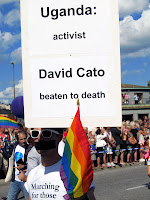Following our five day visit to the Swedish island of
Gotland, we can now co-opt
Bogart’s great line in the closing
scene of Casablanca; “We’ll always have Gotland.” Gotland, which lies about 50 miles off the
east coast of Sweden in the Baltic Sea, was for us a magical place, beginning
with a 50 minute bus ride and a three hour cruise to get there. It invited us to be absorbed by its
beauty, charm and history, reaching as far back as the Stone Age. Here, the Vikings are the new kids on the
block.
 |
| Kerstin, Helen & Lars |
The trip to Gotland came about from Helen’s friendship with
Kerstin, whom she met in the gym facilities near our apartment. Kerstin
(pronounced SHEARS tin), who was born and raised on Gotland, is a marvelous
person in all ways imaginable. She has been married to Lars, who is also a marvelous individual in every way, for nearly 40 years. Together they made possible our Gotland
odyssey as well as opening a window for us to better understand Swedish life.
For dessert one night we enjoyed a cake in honor of Lars’s
name day. Who knew? Another day we were positively
delighted with Kerstin’s and Lars’s rendition of Helan Gå, a traditional
Swedish drinking song as we hoisted our glasses of Schnapps in a ritual toast
customary when eating herring. As Lars
noted, his father faithfully combined the consumption of Schnapps with
herring. Some customs are just worth
preserving. Another dinner conversation
had us mimicking the opening tune to Bonanza, only to have Kerstin and Lars join
in.
 |
| Sitting Area in our Cottage |
We slept in a small summer cottage adjacent to the larger
cottage that Kerstin’s parents had left her.
The cottages are a one minute walk through wind-blown pine trees and
sea grass to where the waters of the Baltic Sea lap against the shore.


With Lars at the wheel of their car, we toured the northern bays
and inlets of Gotland. We climbed among
the limestone pillars left behind where water once covered what is now dry
land.
We toured only a handful of the 92
churches on the island and marveled at the endeavors of the island inhabitants
in the 13th century of raising structures to worship Jesus. Along the way we also admired some of the local handiwork of Kristen’s father, an international stone cutter.
We spent some time in Visby, a walled medieval city and
UNESCO World Heritage site. The old part
of Visby, inside the original city walls, is a charming city of narrow streets
and historic buildings. Our visit had
the added pleasure of coinciding with a weeklong medieval festival. In the US we have enjoyed visiting a Renaissance
Festival with its various reminders of far-off places in a distant time.

In Visby the event may have replicated a
distant time, but once upon a time, street jesters, selling woolen items and the roasting of whole
lambs on open fires were local events.
Our American sensibilities just have a hard time associating the ground
on which we walked with the footsteps of people who walked the same streets in
the 1200’s.
We enjoyed a Sunday service in Visby’s domkirka (cathedral)
St. Maria, built in 1225. The service was
mostly in Swedish with a bit of Latin mixed in to commemorate the medieval festival
in Visby. Regardless of language, we
considered the experience a gift of spiritual renewal. Amen and amen!



 We took several tours to explore Iceland's natural wonders. We peered from the
rim of an inactive volcano into a languid pool of water that now fills the once
belching behemoth. Elsewhere we stood with other tourists and
watched the active geology of Iceland produce a geyser that blasted heated
water high into the cool air. We wandered in awe in the mist of Gullfoss or
“golden waterfall.” It was a sight of
wonder lending justification to it being one of Iceland’s biggest attractions.
We took several tours to explore Iceland's natural wonders. We peered from the
rim of an inactive volcano into a languid pool of water that now fills the once
belching behemoth. Elsewhere we stood with other tourists and
watched the active geology of Iceland produce a geyser that blasted heated
water high into the cool air. We wandered in awe in the mist of Gullfoss or
“golden waterfall.” It was a sight of
wonder lending justification to it being one of Iceland’s biggest attractions.
 A guided tour in the National Museum of Iceland gave us
insights into early Icelanders, actually Norsemen from Norway, Sweden and
Denmark, who stopped off in Ireland to pick up women slaves on their way to
Iceland beginning in about 874 AD. It’s not surprising to see redheads about on
the island; 70% of the immigrants were women from Ireland. The stationing of British and US soldiers during WW II brought
Western culture and propelled the island rapidly into the 20th
century.
A guided tour in the National Museum of Iceland gave us
insights into early Icelanders, actually Norsemen from Norway, Sweden and
Denmark, who stopped off in Ireland to pick up women slaves on their way to
Iceland beginning in about 874 AD. It’s not surprising to see redheads about on
the island; 70% of the immigrants were women from Ireland. The stationing of British and US soldiers during WW II brought
Western culture and propelled the island rapidly into the 20th
century. 


























